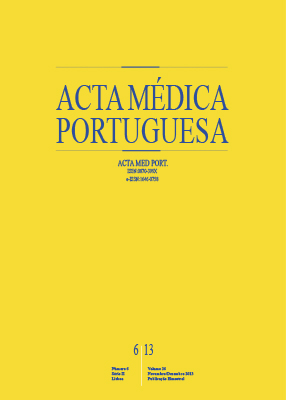Gonadal Function in Turner Syndrome
DOI:
https://doi.org/10.20344/amp.1316Abstract
Introduction: Turner syndrome is characterized by the absence, total or partial, of one X chromosome in females, being one of the most frequent chromosomal abnormalities. Diagnosis is made by karyotype. Turner syndrome manifestations include primary hypogonadism, before or after puberty (gonadal dysgenesis). The degree and extent of gonadal disfunction are variable.Objectives: We intended to assess clinical, karyotype, gonadal function and pelvic ultrasound characteristics in women with Turner syndrome.
Material and Methods: Retrospective study of patients with Turner syndrome followed in Endocrinology and Human Reproduction Departments of Hospitais da Universidade de Coimbra - Centro Hospitalar e Universitário de Coimbra, E.P.E. We evaluated the entire sample and considered group 1 (with spontaneous puberty and menarche) and group 2 (without spontaneous puberty). Parameters assessed: age at initial study, puberty (Tanner stages), karyotype, FSH, pelvic ultrasound (initial and after puberty), diagnostic laparoscopy and pubertal induction. Statistical Program: SPSS (20.0).
Results: Global sample: 79 patients, 14.7 ± 6.6 years. No pubertal signs in 57.1%; 67.1% with primary amenorrhea and 6.6% with secondary amenorrhea. Karyotype: X monosomy-37.2%, mosaicism-37.2%, X structural changes-25.6%. Median FSH of 59.5 mIU/ mL. Initial ultrasound: normal uterus 34.2%, atrophic uterus 65.8%; normal ovaries 21.6%, atrophic ovaries 78.4%, ovarian follicles in 5.1%. Post-puberty ultrasound: normal uterus 67.9%, atrophic uterus 32.1%; normal ovaries 36.4%, atrophic ovaries 63.6%. Laparoscopy was performed in 16 (20.3%) patients, confirming the sonographic findings. Only two women with induced puberty became pregnant: one spontaneously, interrupted; another by donated oocytes, normal outcome. Group 1 (with spontaneous puberty and menarche):
20 (25.3%) patients, 16.1 ± 8.9 years. Tanner at baseline: M1-22.2%, M2-33.3%, M3-16.7%, M4-16.7%, M5-11.1%. Karyotype: mosaicism-65%, X structural changes-20%, X monosomy-15%. Median FSH of 7 mUI/mL. Initial ultrasound: normal uterus-72.2%,atrophic uterus 27.8%; normal ovaries 63.2%, atrophic ovaries 36.8%. Post-puberty ultrasound: normal uterus 100%; normal ovaries 72.7%, atrophic ovaries 27.3%. Group 2 (without spontaneous puberty): 59 (74.7%) patients, 14.0 ± 5.5 years. Tanner at baseline: M1-69.2%, M2-13.5%, M3-5.8%, M4-3.8%, M5-7.7%. Karyotype: X monosomy-43.9%, X structural changes-28.1% mosaicism-28.1%. Median FSH of 74 mUI/mL. Initial ultrasound: normal uterus 20.4%, atrophic uterus 79.6%; normal ovaries 7.4%, atrophic ovaries
92.6%. Post-puberty ultrasound: normal uterus 60.0%, atrophic uterus 40.0%; normal ovaries 27.3%, atrophic ovaries 72.7%. Pubertal induction at 16.1 ± 4.1 years, with bone age of 12.7 ± 1.6 years. Groups 1 and 2 differ significantly in karyotype (p = 0.010), median FSH (p < 0.001), and uterine and ovarian dimensions (p < 0.001).
Conclusions: Most patients had gonadal dysfunction and needed pubertal induction. Spontaneous puberty with menarche occurred in 25.3% of patients (predominantly mosaics). 43.9% of patients with pubertal induction had X monosomy. These patients fertility is compromised and, in some cases, we should refer to assisted reproductive specialist for pregnancy or fertility preservation.
Downloads
Downloads
Published
How to Cite
Issue
Section
License
All the articles published in the AMP are open access and comply with the requirements of funding agencies or academic institutions. The AMP is governed by the terms of the Creative Commons ‘Attribution – Non-Commercial Use - (CC-BY-NC)’ license, regarding the use by third parties.
It is the author’s responsibility to obtain approval for the reproduction of figures, tables, etc. from other publications.
Upon acceptance of an article for publication, the authors will be asked to complete the ICMJE “Copyright Liability and Copyright Sharing Statement “(http://www.actamedicaportuguesa.com/info/AMP-NormasPublicacao.pdf) and the “Declaration of Potential Conflicts of Interest” (http:// www.icmje.org/conflicts-of-interest). An e-mail will be sent to the corresponding author to acknowledge receipt of the manuscript.
After publication, the authors are authorised to make their articles available in repositories of their institutions of origin, as long as they always mention where they were published and according to the Creative Commons license.









